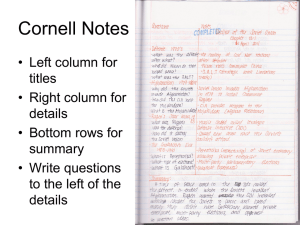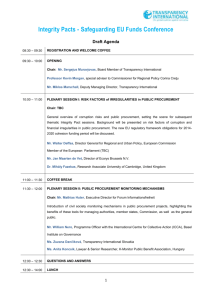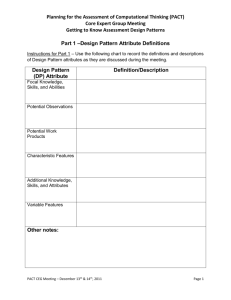World Language
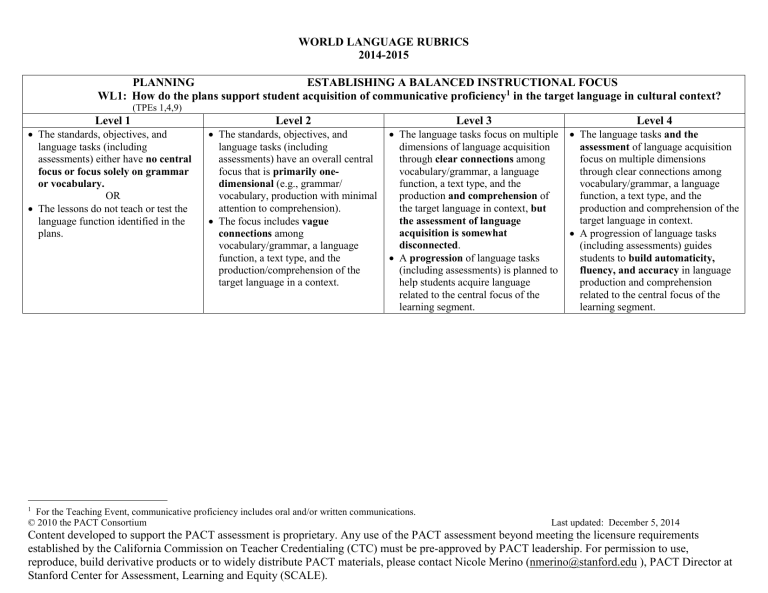
WORLD LANGUAGE RUBRICS
2014-2015
PLANNING ESTABLISHING A BALANCED INSTRUCTIONAL FOCUS
WL1: How do the plans support student acquisition of communicative proficiency 1 in the target language in cultural context?
(TPEs 1,4,9)
Level 1
The standards, objectives, and language tasks (including assessments) either have no central focus or focus solely on grammar or vocabulary.
OR
The lessons do not teach or test the language function identified in the plans.
Level 2
The standards, objectives, and language tasks (including assessments) have an overall central focus that is primarily onedimensional (e.g., grammar/ vocabulary, production with minimal
attention to comprehension).
The focus includes vague connections among vocabulary/grammar, a language function, a text type, and the production/comprehension of the target language in a context.
Level 3
The language tasks focus on multiple dimensions of language acquisition through clear connections among vocabulary/grammar, a language function, a text type, and the production and comprehension of the target language in context, but the assessment of language acquisition is somewhat disconnected .
A progression of language tasks
(including assessments) is planned to help students acquire language related to the central focus of the learning segment.
Level 4
The language tasks and the assessment of language acquisition focus on multiple dimensions through clear connections among vocabulary/grammar, a language function, a text type, and the production and comprehension of the target language in context.
A progression of language tasks
(including assessments) guides students to build automaticity, fluency, and accuracy in language production and comprehension related to the central focus of the learning segment.
1 For the Teaching Event, communicative proficiency includes oral and/or written communications.
© 2010 the PACT Consortium Last updated: December 5, 2014
Content developed to support the PACT assessment is proprietary. Any use of the PACT assessment beyond meeting the licensure requirements established by the California Commission on Teacher Credentialing (CTC) must be pre-approved by PACT leadership. For permission to use, reproduce, build derivative products or to widely distribute PACT materials, please contact Nicole Merino (nmerino@stanford.edu ), PACT Director at
Stanford Center for Assessment, Learning and Equity (SCALE).
WORLD LANGUAGE RUBRICS
2014-2015
PLANNING MAKING CURRICULUM ACCESSIBLE
WL2: How do the plans make the curriculum accessible to the students in the class? (TPEs 1,4,5,6,7,8,9)
Level 1
Plans for language production and comprehension have little relationship to students’ experiential backgrounds 2 , interests, or prior levels of language acquisition 3 that are relevant to the standards and/or objectives.
OR
The models of the target language provided to students contain significant and consistent inaccuracies (e.g., in vocabulary, grammar, text types).
Level 2
Plans for language production and comprehension draw on students’ experiential backgrounds, interests, or prior levels of language acquisition to help students acquire language related to the standards and/or objectives .
Plans for the implementation of learning tasks include support 4 to help students who often struggle with the production and/or comprehension of oral/written language.
Level 3
Plans for language production and comprehension draw on students’ prior levels of language acquisition as well as experiential backgrounds or interests to help students acquire language related to the standards and/or objectives.
Plans for implementation of learning tasks include scaffolding or other structured forms of support
5
to provide access to standards and/or objectives appropriate to the course level .
Level 4
All components of Level 3 plus:
Plans for language production and comprehension include wellintegrated instructional strategies that are tailored to address a variety of specific student needs .
2 Cultural, social, economic
3 In or out of school
4 Such as strategic groupings of students; circulating to monitor student understanding during independent or group work; checking on particular students.
5 Such as multiple ways of representing content; modeling strategies; providing graphic organizers, rubrics, or sample work.
© 2010 the PACT Consortium Last updated: December 5, 2014
Content developed to support the PACT assessment is proprietary. Any use of the PACT assessment beyond meeting the licensure requirements established by the California Commission on Teacher Credentialing (CTC) must be pre-approved by PACT leadership. For permission to use, reproduce, build derivative products or to widely distribute PACT materials, please contact Nicole Merino (nmerino@stanford.edu ), PACT Director at
Stanford Center for Assessment, Learning and Equity (SCALE).
WORLD LANGUAGE RUBRICS
2014-2015
PLANNING DESIGNING ASSESSMENTS
WL3: What opportunities do students have to demonstrate their acquisition of the standards and/or objectives for the learning
Level 1 segment? (TPEs 2,3)
There are limited opportunities provided for students to develop proficiency in what is assessed.
OR
There is a significant mismatch between one or more assessment instruments or methods and the standards/objectives being assessed.
Level 2
Opportunities are provided for students to develop proficiency in what is assessed .
The assessments of the standards and/or objectives focus primarily on accuracy.
Level 3
Opportunities are provided for students to develop proficiency in what is assessed.
The assessments of the standards and/or objectives focus on communicative proficiency in context as well as accuracy.
The assessments monitor both production (speaking/writing) and reception (listening/reading) of the target language.
Level 4
All components of Level 3 plus:
Assessments are modified, adapted, and/or designed to allow students with special needs opportunities to demonstrate proficiency relative to the standards and/or objectives.
© 2010 the PACT Consortium Last updated: December 5, 2014
Content developed to support the PACT assessment is proprietary. Any use of the PACT assessment beyond meeting the licensure requirements established by the California Commission on Teacher Credentialing (CTC) must be pre-approved by PACT leadership. For permission to use, reproduce, build derivative products or to widely distribute PACT materials, please contact Nicole Merino (nmerino@stanford.edu ), PACT Director at
Stanford Center for Assessment, Learning and Equity (SCALE).
WORLD LANGUAGE RUBRICS
2014-2015
INSTRUCTION ENGAGING STUDENTS IN LEARNING
WL4: How does the candidate actively engage students to develop their own abilities to communicate in the target language in
Level 1 culturally appropriate ways? (TPEs 1,5,11)
Students have limited opportunities in the clips to improve their abilities to communicate in the target language in culturally appropriate ways 6 .
OR
The clips do not focus on communicating in the target language in culturally appropriate ways.
OR
Classroom management is problematic and student behavior interferes with learning .
Level 2
Strategies seen in the clips for engaging students in language production/comprehension offer opportunities for students to develop their own abilities to communicate in the target language in culturally appropriate ways.
Level 3
Strategies seen in the clips for engaging students in language production/comprehension offer structured opportunities for students to develop their own abilities to actively communicate in the target language in culturally appropriate ways.
These strategies reflect attention to student characteristics and/or language needs .
Level 4
Strategies seen in the clips for engaging students in language production/comprehension offer structured opportunities for students to actively communicate in the target language in culturally appropriate ways.
These strategies are explicit and clearly reflect attention to students with diverse characteristics and/or language needs.
6 For students at Levels 3 and 4, this includes use of the appropriate academic register.
© 2010 the PACT Consortium Last updated: December 5, 2014
Content developed to support the PACT assessment is proprietary. Any use of the PACT assessment beyond meeting the licensure requirements established by the California Commission on Teacher Credentialing (CTC) must be pre-approved by PACT leadership. For permission to use, reproduce, build derivative products or to widely distribute PACT materials, please contact Nicole Merino (nmerino@stanford.edu ), PACT Director at
Stanford Center for Assessment, Learning and Equity (SCALE).
WORLD LANGUAGE RUBRICS
2014-2015
INSTRUCTION MONITORING STUDENT LEARNING DURING INSTRUCTION
WL5: How does the candidate monitor students’ language production/comprehension during instruction and respond to student questions, comments, and needs? (TPEs 2,5)
Level 1
The candidate primarily monitors language production/comprehension by eliciting student use of the target language and evaluating the grammar and vocabulary as correct or incorrect .
Candidate responses are not likely to promote communicative proficiency .
OR
Materials or candidate responses model inappropriate vocabulary, grammar, or use of language that will interfere with the acquisition of language appropriate for the cultural context.
Level 2
The candidate monitors students’ language production/comprehension by eliciting students’ use of the target language and evaluating it in ways that go beyond the correct usage of grammar and vocabulary .
Candidate responses represent reasonable attempts to improve student abilities to communicate in the target language in culturally appropriate ways .
Level 3
The candidate monitors language production/comprehension by eliciting students’ use of the target language and evaluating it in ways that go beyond the correct usage of grammar and vocabulary to address communicative proficiency in a cultural context .
Candidate responses build on the student responses to guide the improvement of students’ abilities to communicate in the target language in culturally appropriate ways.
Level 4
All components of Level 3 plus:
Candidate responses help students learn strategies for improving their automaticity, fluency, and/or accuracy .
© 2010 the PACT Consortium Last updated: December 5, 2014
Content developed to support the PACT assessment is proprietary. Any use of the PACT assessment beyond meeting the licensure requirements established by the California Commission on Teacher Credentialing (CTC) must be pre-approved by PACT leadership. For permission to use, reproduce, build derivative products or to widely distribute PACT materials, please contact Nicole Merino (nmerino@stanford.edu ), PACT Director at
Stanford Center for Assessment, Learning and Equity (SCALE).
WORLD LANGUAGE RUBRICS
2014-2015
ASSESSMENT ANALYZING STUDENT WORK FROM AN ASSESSMENT
WL6: How does the candidate demonstrate an understanding of students’ communicative proficiency with respect to the
Level 1 standards/objectives? (TPEs 1,3)
The criteria/rubric and analysis have little connection with the identified standards/objectives or focus solely on errors in grammar and vocabulary with no assessment of communicative proficiency.
OR
Student work samples do not support the conclusions in the analysis.
Level 2
The criteria/rubric and analysis focus on students’ degree of automaticity, fluency and/or accuracy in relationship to identified standards/objectives.
The analysis of whole class performance describes some differences in levels of students’ communicative proficiency for the language function assessed.
Level 3
The criteria/rubric and analysis focus on patterns in automaticity, fluency, and/or accuracy to analyze students’ communicative proficiency in relation to standards/objectives.
Specific patterns are identified for individuals or subgroup(s) in addition to the whole class.
Level 4
All components of Level 3 plus:
The criteria/rubric and analysis also focus on students’ use of strategies for comprehension/production .
The analysis is clear and detailed.
ASSESSMENT USING ASSESSMENT TO INFORM TEACHING
WL7: How does the candidate use analysis of students’ communicative proficiency to propose next steps in instruction? (TPEs 3,4)
Level 1
Next steps are vaguely related to or not aligned with the identified student communicative proficiency needs.
OR
Next steps are not described in sufficient detail to understand them.
OR
Next steps are based on inaccurate conclusions about student communicative proficiency from the assessment analysis.
Level 2
Next steps focus on improving students’ communicative proficiency through general support that addresses some students’ identified needs .
Next steps are based on accurate conclusions about student proficiency on the assessment and are described in sufficient detail to understand them.
Level 3
Next steps focus on improving student performance through targeted support to individuals and groups to address specific identified needs .
Next steps are based on whole class patterns of performance and some patterns for individuals and/or subgroups and are described in sufficient detail to understand them.
Level 4
All components of Level 3 plus:
Next steps demonstrate a strong understanding of both the identified standards/ objectives and of individual students and/or subgroups .
© 2010 the PACT Consortium Last updated: December 5, 2014
Content developed to support the PACT assessment is proprietary. Any use of the PACT assessment beyond meeting the licensure requirements established by the California Commission on Teacher Credentialing (CTC) must be pre-approved by PACT leadership. For permission to use, reproduce, build derivative products or to widely distribute PACT materials, please contact Nicole Merino (nmerino@stanford.edu ), PACT Director at
Stanford Center for Assessment, Learning and Equity (SCALE).
WORLD LANGUAGE RUBRICS
2014-2015
ASSESSMENT USING FEEDBACK TO PROMOTE STUDENT LEARNING
WL8: What is the quality of feedback to students? (TPEs 3,4)
Level 1
Feedback is general and provides little guidance for improvement related to learning objectives.
OR
The feedback contains significant inaccuracies .
Level 2
Timely feedback identifies what was done well and areas for improvement related to specific learning objectives.
Level 3
Specific and timely feedback helps the student understand what s/he has done well , and provides guidance for improvement.
Level 4
Specific and timely comments are supportive and prompt analysis by the student of his/her own performance .
The feedback shows strong understanding of students as individuals in reference to the content and language objectives they are trying to meet.
© 2010 the PACT Consortium Last updated: December 5, 2014
Content developed to support the PACT assessment is proprietary. Any use of the PACT assessment beyond meeting the licensure requirements established by the California Commission on Teacher Credentialing (CTC) must be pre-approved by PACT leadership. For permission to use, reproduce, build derivative products or to widely distribute PACT materials, please contact Nicole Merino (nmerino@stanford.edu ), PACT Director at
Stanford Center for Assessment, Learning and Equity (SCALE).
WORLD LANGUAGE RUBRICS
2014-2015
REFLECTION MONITORING STUDENT PROGRESS
WL9: How does the candidate monitor students’ language acquisition and make appropriate adjustments in instruction during
Level 1 the learning segment? (TPEs 2,10,12,13)
Daily reflections indicate inconsistent monitoring of students’ communicative proficiency.
There is limited evidence of adjusting instruction in response to observed problems, e.g., student confusion, a lack of challenge, time management.
Level 2
Daily reflections identify what students could or could not do within each lesson .
Adjustments to instruction are focused on improving directions for learning tasks, time management, or reteaching.
Level 3
Daily reflections indicate monitoring of student progress toward acquiring communicative proficiency with respect to the standards/objectives for the learning segment .
Adjustments to instruction are focused on addressing some individual and collective language acquisition needs .
Level 4
All components of Level 3 plus:
Adjustments to instruction are focused on developing automaticity, fluency (both productive and receptive), accuracy in the target language and/or students’ familiarity with cultures that use that language.
REFLECTION REFLECTING ON LEARNING
WL10: How does the candidate use research, theory, and reflections on teaching and learning to guide practice? (TPEs 10,11,12,13)
Level 1
Reflections on teaching practice are erroneously supported through a significant misapplication of theory or research principles.
OR
Changes in teaching practice are not based on reasonable assumptions about how acquisition of the target language was affected by planning, instruction, or assessment decisions.
Level 2
Reflections on teaching practice are consistent with principles from
theory and research.
Changes in teaching practice are based on reasonable assumptions about how acquisition of the target language was affected by planning, instruction, or assessment decisions.
Level 3
Reflections on teaching practice are based on sound knowledge of research and theory linked to
knowledge of students in the class.
Changes in teaching practice are based on reasonable assumptions about how acquisition of the target language was affected by planning, instruction, or assessment decisions.
Level 4
Reflections on teaching practice integrate sound knowledge of research and theory about effective teaching practice, knowledge of the process of language acquisition, and knowledge of students in the class .
Changes in teaching practice are specific and strategic to improve individual and collective student understanding of standards/objectives.
© 2010 the PACT Consortium Last updated: December 5, 2014
Content developed to support the PACT assessment is proprietary. Any use of the PACT assessment beyond meeting the licensure requirements established by the California Commission on Teacher Credentialing (CTC) must be pre-approved by PACT leadership. For permission to use, reproduce, build derivative products or to widely distribute PACT materials, please contact Nicole Merino (nmerino@stanford.edu ), PACT Director at
Stanford Center for Assessment, Learning and Equity (SCALE).
WORLD LANGUAGE RUBRICS
2014-2015
ACADEMIC LANGUAGE 7
Level 1
Candidate’s description of students’ target language proficiency at lower levels is limited to what they CANNOT do .
Language genre(s) 9 discussed are only tangentially related to the academic purposes of the learning segment.
Candidate identifies unfamiliar vocabulary without considering other linguistic features.
OR
Candidate did not identify any language demands within the learning and assessment tasks.
UNDERSTANDING LANGUAGE DEMANDS 8 AND RESOURCES
WL11: How does the candidate identify the language demands of learning tasks and assessments relative to the students’ current levels of academic language proficiency?
Level 2
Candidate describes academic language strengths and needs of students at different levels of target language proficiency .
The language genre(s) discussed are clearly related to the academic purposes of the learning segment and some language demands are identified .
Candidate identifies vocabulary that may be problematic for students .
Level 3
Candidate describes target language strengths and needs of students at different levels of target language proficiency.
The language genre(s) discussed are clearly related to the academic purpose of the learning segment and language demands are identified. One or more linguistic features and/or textual resources of the genre are explicitly identified .
Candidate identifies essential vocabulary for students to actively engage in specific language tasks.
Level 4
Candidate describes target language strengths and needs of students at the full range of target language proficiency .
The language genre discussed is clearly related to the academic purpose of the learning segment and language demands are identified. One or more genrerelated linguistic features or textual resources of the specific tasks/materials are explicitly identified and related to students’ varied levels of target language proficiency .
Candidate identifies for instruction related clusters of vocabulary .
7 Academic language is a minor focus, if a focus at all, for most World Language candidates. For courses focusing on Levels 1 and 2 of the Language Learning Continuum, the major focus is on being able to talk about familiar content in the target language. The two Academic Language rubrics should only be scored for candidates focusing on Levels 3 and 4.
8 Language demands might include: distinguishing literal meanings of words and phrases from their symbolic meanings; using technical language to explain intuitive responses to text; using complex sentences to express interpretations; using precise language to explain the effects of literary devices; combining argument and textual references to persuading an audience to accept an interpretation
9
Key genres in this area might include: recounting plot development; engaging in collaborative and oral understanding of a text ; e xplaining a response to a text; interpreting figurative language; evaluating interpretations of a text.
© 2010 the PACT Consortium Last updated: December 5, 2014
Content developed to support the PACT assessment is proprietary. Any use of the PACT assessment beyond meeting the licensure requirements established by the California Commission on Teacher Credentialing (CTC) must be pre-approved by PACT leadership. For permission to use, reproduce, build derivative products or to widely distribute PACT materials, please contact Nicole Merino (nmerino@stanford.edu ), PACT Director at
Stanford Center for Assessment, Learning and Equity (SCALE).
WORLD LANGUAGE RUBRICS
2014-2015
ACADEMIC LANGUAGE
DEVELOPING STUDENTS’ ACADEMIC LANGUAGE REPERTOIRE
WL12: How do the candidate’s planning, instruction, and assessment support academic language development? (TPEs 1,4,7,8)
Level 1
The candidate gives little or sporadic support to students to meet the language demands of the learning tasks.
OR
Language and/or content is oversimplified to the point of limiting student access to the core content of the curriculum.
Level 2
The candidate uses scaffolding or other support 10 to address identified gaps between students’ current language abilities and the language demands of the learning tasks and assessments, including selected genres and key linguistic features.
Candidate articulates why instructional strategies chosen are likely to support aspects of students’ language development.
Level 3
The candidate’s use of scaffolding or other support provides access to core content while also providing explicit models, opportunities for practice, and feedback for students t o develop further language proficiency for selected genres and key linguistic features.
The candidate articulates why the instructional strategies chosen are likely to support specific aspects of students’ language development for different levels of language proficiency.
Level 4
The candidate’s use of scaffolding or other support provides access to core content while also providing explicit models, opportunities for practice, and feedback for students to develop further language proficiency related to the demands of the learning tasks and assessments.
The candidate articulates why the instructional strategies chosen are likely to support specific aspects of students’ language development for the full range of language proficiency and projects ways in which the scaffolds can be removed as proficiency increases.
10 Such support might include one or more of the following: modeling of strategies for comprehending or constructing texts; explicit communication of the expected features of oral or written texts (e.g., using rubrics, models, and frames); use of strategies that provide visual representations of content while promoting content-based literacy development (e.g., graphic organizers); vocabulary development techniques (context cues, categorization, analysis of word parts, etc.); opportunities to work together with students with different kinds of language and literacy skills, etc.
© 2010 the PACT Consortium Last updated: December 5, 2014
Content developed to support the PACT assessment is proprietary. Any use of the PACT assessment beyond meeting the licensure requirements established by the California Commission on Teacher Credentialing (CTC) must be pre-approved by PACT leadership. For permission to use, reproduce, build derivative products or to widely distribute PACT materials, please contact Nicole Merino (nmerino@stanford.edu ), PACT Director at
Stanford Center for Assessment, Learning and Equity (SCALE).
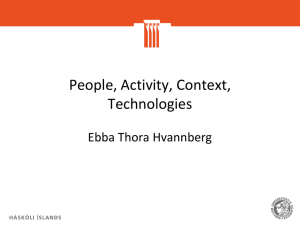
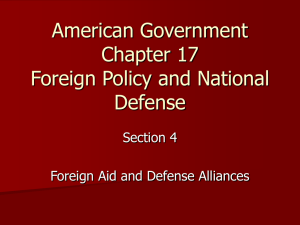
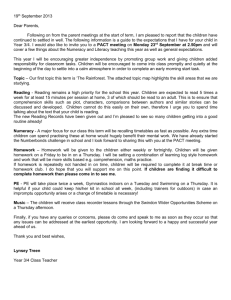
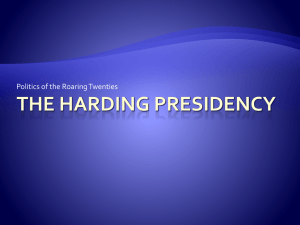
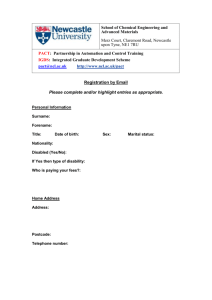
![Best-fit Decisions [, 25 KB]](http://s3.studylib.net/store/data/006613263_1-62a61f810693250e9828b38f77c693b2-300x300.png)
